On Sunday, April 8, 1945, the liberation of Deventer was near, and the Canadian army had approached the city within just a few kilometers, coming from the south, from the Zutphen direction. Infantry regiments such as The Royal Winnipeg Rifles and The Canadian Scottish were mainly responsible for capturing the city. The sounds of war were clearly audible, and tension rose by the hour.
A unit of the Dutch Domestic Forces (Binnenlandse Strijdkrachten, BS) in Deventer was ordered to secure the Twentol Bridge over the Nieuwe Haven on Zutphenseweg, at the southern edge of the city, to support the Canadian advance. The group consisted almost entirely of students from the Colonial Agricultural College in Deventer. At 24 years old, Jan Gennep van Lührs was the oldest and served as the group’s commander.
Lightly armed, the group took up position in the temporarily abandoned factory of the Twentol Oil Company, also located on Zutphenseweg. Though risky due to the flammable stock inside, the site was strategically located next to the bridge and offered a good vantage point from the upper floor.
What no one in the group knew was that Canadian military leadership had decided not to enter the city via Zutphenseweg. Heavy German resistance was expected along that route, and Brigadier General Gibson and his staff instead chose a wide flanking maneuver to approach Deventer from the northeast rather than the south.
The Twentol resistance group was unaware of this change in plan and therefore remained on watch for several days, losing their opportunity to retreat easily from the factory — as there had been no German presence at the bridge up to that point. On Monday morning, April 9, the situation remained unchanged. The group was still supplied by 19-year-old resistance courier Corry Bosch, who had married fellow resistance member Joost van Baalen (22) just two weeks earlier. They were determined to stay together.
On Tuesday, April 10 — the day of Deventer’s liberation — the calm around Twentol was shattered. German units were being pushed southward through the city, and suddenly, holding the Twentol Bridge became strategically important for the German retreat. In café Erbers, on the opposite side of the bridge, a German observation post was set up with a small patrol that began scouting the area.
The resistance group’s presence was discovered, and the factory was surrounded. A firefight broke out, during which Jan Gennep van Lührs was killed. The Germans then set fire to the building, literally smoking out the resistance fighters. One member died in the flames. Gerard Verhoeven managed to escape, but the remaining five were captured. They were taken to a German command post and subsequently executed.
